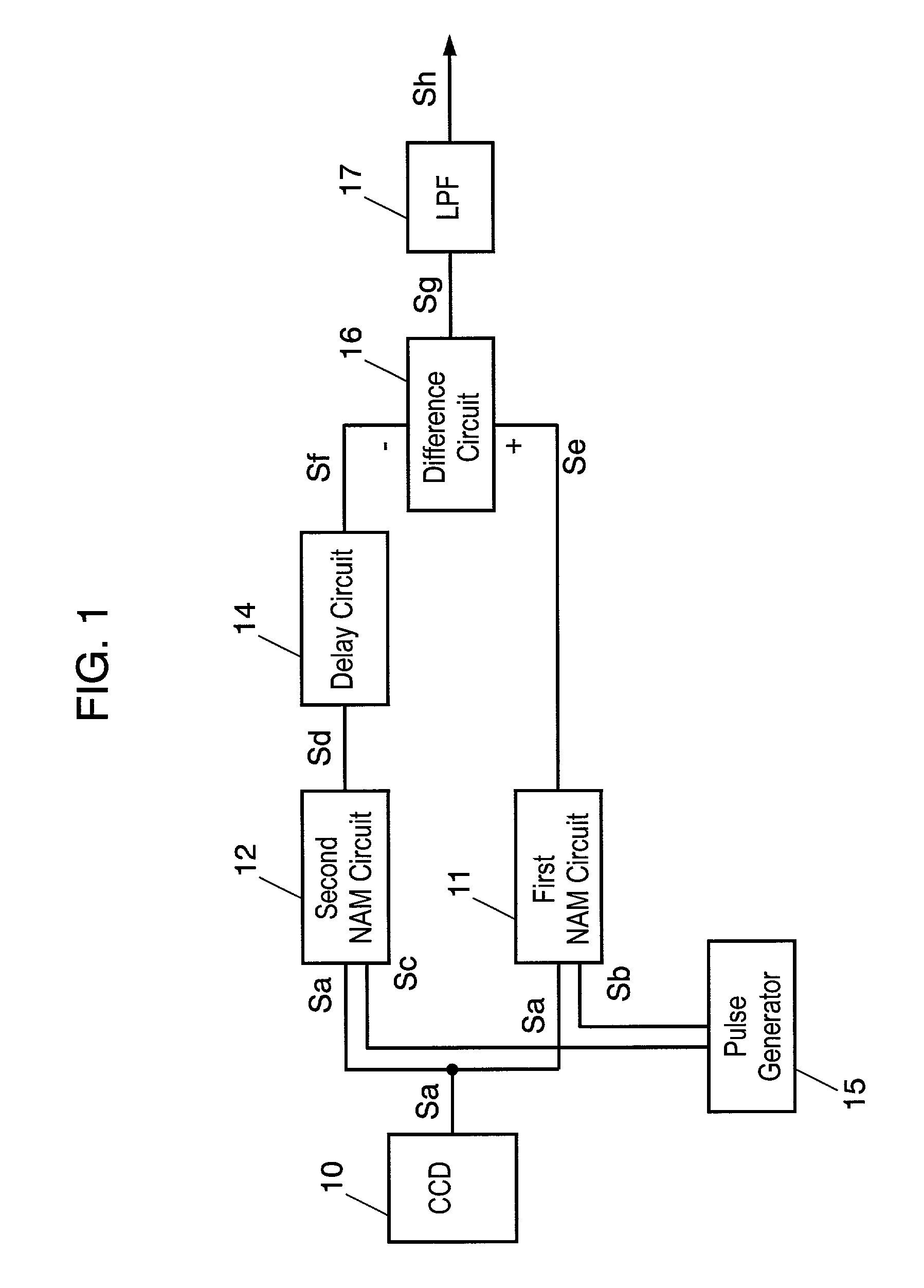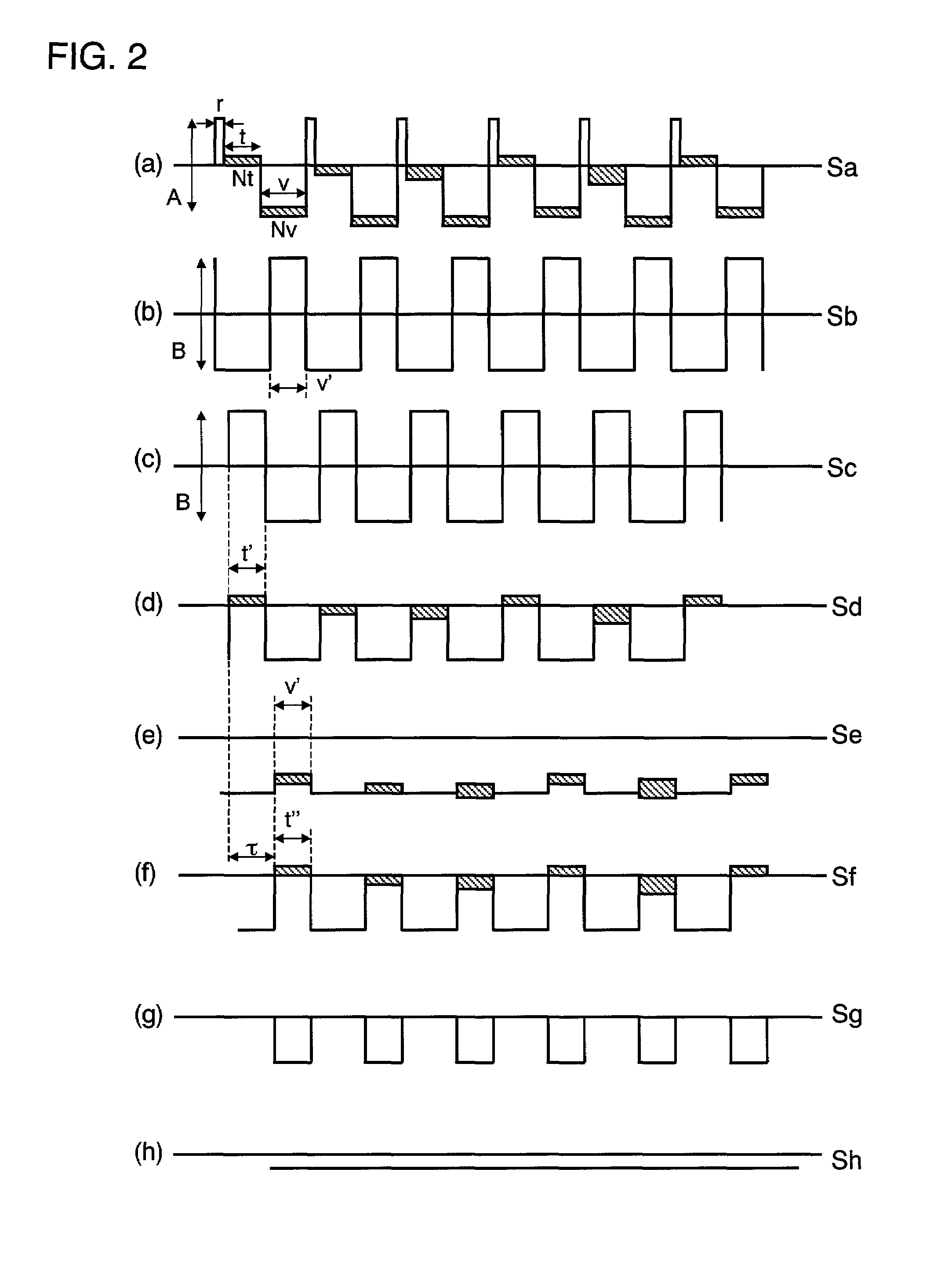Noise reduction circuit for CCD output signal
a noise reduction circuit and output signal technology, applied in the field of noise reduction circuits, can solve the problems of hardly getting enough noise reduction effect in the noise reduction circuit, reducing sensitivity, and reducing the dynamic range, so as to reduce the noise in the output signal of ccd, reduce the dynamic range, and reduce the summing circuit
- Summary
- Abstract
- Description
- Claims
- Application Information
AI Technical Summary
Benefits of technology
Problems solved by technology
Method used
Image
Examples
embodiment 1
[0047]A noise reduction circuit in accordance with embodiment 1 of the present invention is described hereinafter with reference to FIG. 1, FIG. 2, and FIG. 7.
[0048]FIG. 1 is a block diagram illustrating a noise reduction circuit in accordance with embodiment 1. An output terminal of charge coupled device (CCD) 10 is connected to one input terminal of first non-additive mixing (NAM) circuit 11 and one input terminal of second NAM circuit 12. Output terminals of pulse generator 15 are connected to another input terminal of first NAM circuit 11 and another input terminal of second NAM circuit 12 respectively. Pulse generator 15 outputs two types of pulse signals Sb and Sc which have the same period that output signal Sa of CCD 10 has. A difference between the two types of pulse signals Sb and Sc is described later with reference to FIG. 2.
[0049]First pulse signal Sb of these two type signals Sb and Sc is input to first NAM circuit, and second pulse signal Sc is input to second NAM cir...
embodiment 2
[0069]A noise reduction circuit in accordance with embodiment 2 of the present invention is described hereinafter with reference to FIG. 3, FIG. 4, and FIG. 7.
[0070]First, FIG. 3 is a block diagram illustrating a noise reduction circuit in accordance with embodiment 2. An output terminal of CCD 20 is connected to one input terminal of first NAM circuit 21 and an input terminal of delay circuit 24. An output terminal of delay circuit 24 is connected to one input terminal of second NAM circuit 22. Delay circuit 24 receives CCD output signal Ta of CCD 20, delays signal Ta, and outputs output delay signal Tb to second NAM circuit 22. An output terminal of pulse generator 25 is connected to another input terminal of first NAM circuit 21 and another input terminal of second NAM circuit 22. Pulse generator 25 outputs one type of pulse signal Tc which has the same period that an output signal Ta of CCD 20 has.
[0071]First NAM circuit 21 selects and outputs a lower level signal between CCD ou...
embodiment 3
[0090]A noise reduction circuit in accordance with embodiment 3 of the present invention is described hereinafter with reference to FIG. 5, FIG. 6, and FIG. 7.
[0091]FIG. 5 is a block diagram illustrating a noise reduction circuit in accordance with embodiment 3. An output terminal of CCD 30 is connected to one input terminal of first NAM circuit 31 and an input terminal of inverting circuit 33. An output terminal of inverting circuit 33 is connected to an input terminal of delay circuit 34, and an output terminal of delay circuit 34 is connected to one input terminal of second NAM circuit 32. Inverting circuit 33 inverts output signal Ua of CCD 30, and outputs inverted signal Ub. Delay circuit 34 receives inverted signal Ub from inverting circuit 33, delays signal Ub, and outputs signal Uc to second NAM circuit 32. An output terminal of pulse generator 35 is connected to another input terminal of first NAM circuit 31 and another input terminal of second NAM circuit 32. Pulse generat...
PUM
 Login to View More
Login to View More Abstract
Description
Claims
Application Information
 Login to View More
Login to View More - R&D
- Intellectual Property
- Life Sciences
- Materials
- Tech Scout
- Unparalleled Data Quality
- Higher Quality Content
- 60% Fewer Hallucinations
Browse by: Latest US Patents, China's latest patents, Technical Efficacy Thesaurus, Application Domain, Technology Topic, Popular Technical Reports.
© 2025 PatSnap. All rights reserved.Legal|Privacy policy|Modern Slavery Act Transparency Statement|Sitemap|About US| Contact US: help@patsnap.com



